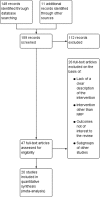Impact of neonatal resuscitation trainings on neonatal and perinatal mortality: a systematic review and meta-analysis
- PMID: 29637172
- PMCID: PMC5862177
- DOI: 10.1136/bmjpo-2017-000183
Impact of neonatal resuscitation trainings on neonatal and perinatal mortality: a systematic review and meta-analysis
Abstract
Background: Training of birth attendants in neonatal resuscitation is likely to reduce birth asphyxia and neonatal mortality. We performed a systematic review and meta-analysis to assess the impact of neonatal resuscitation training (NRT) programme in reducing stillbirths, neonatal mortality, and perinatal mortality.
Methods: We considered studies where any NRT was provided to healthcare personnel involved in delivery process and handling of newborns. We searched MEDLINE, CENTRAL, ERIC and other electronic databases. We also searched ongoing trials and bibliographies of the retrieved articles, and contacted experts for unpublished work. We undertook screening of studies and assessment of risk of bias in duplicates. We performed review according to Cochrane Handbook. We assessed the quality of evidence using the GRADE approach.
Results: We included 20 trials with 1 653 805 births in this meta-analysis. The meta-analysis of NRT versus control shows that NRT decreases the risk of all stillbirths by 21% (RR 0.79, 95% CI 0.44 to 1.41), 7-day neonatal mortality by 47% (RR 0.53, 95% CI 0.38 to 0.73), 28-day neonatal mortality by 50% (RR 0.50, 95% CI 0.37 to 0.68) and perinatal mortality by 37% (RR 0.63, 95% CI 0.42 to 0.94). The meta-analysis of pre-NRT versus post-NRT showed that post-NRT decreased the risk of all stillbirths by 12% (RR 0.88, 95% CI 0.83 to 0.94), fresh stillbirths by 26% (RR 0.74, 95% CI 0.61 to 0.90), 1-day neonatal mortality by 42% (RR 0.58, 95% CI 0.42 to 0.82), 7-day neonatal mortality by 18% (RR 0.82, 95% CI 0.73 to 0.93), 28-day neonatal mortality by 14% (RR 0.86, 95% CI 0.65 to 1.13) and perinatal mortality by 18% (RR 0.82, 95% CI 0.74 to 0.91).
Conclusions: Findings of this review show that implementation of NRT improves neonatal and perinatal mortality. Further good quality randomised controlled trials addressing the role of NRT for improving neonatal and perinatal outcomes may be warranted.
Trial registration number: PROSPERO 2016:CRD42016043668.
Keywords: health services research; mortality; multidisciplinary team-care.
Conflict of interest statement
Competing interests: The authors AP and AB were investigators in two of the studies (Bellad et al and Patel et al) included in the meta-analysis. There were no other competing interest.
Figures












References
-
- David M, Mark D. Obstetrics & Gynaecology: an evidence-based text for MRCOG. 3rd edition London, United Kingdom: Taylor Francis Ltd, 2010.
-
- Australian resuscitation council, New Zealand resuscitation council. The resuscitation of the newborn infant in special circumstances. ARC and NZRC guideline 2010. Emerg Med Australas 2011;23:445–7. doi:10.1111/j.1742-6723.2011.01442_15.x - DOI - PubMed
-
- Wall SN, Lee AC, Niermeyer S, et al. . Neonatal resuscitation in low-resource settings: what, who, and how to overcome challenges to scale up? Int J Gynaecol Obstet 2009;107(Suppl 1):S47–S64. doi:10.1016/j.ijgo.2009.07.013 - DOI - PMC - PubMed
-
- Palme-Kilander C. Methods of resuscitation in low-apgar-score newborn infants-a national survey. Acta Paediatr 1992;81:739–44. doi:10.1111/j.1651-2227.1992.tb12094.x - DOI - PubMed
-
- Kattwinkel J, Niermeyer S, Nadkarni V, et al. . Resuscitation of the newly born infant: an advisory statement from the pediatric working group of the international liaison committee on resuscitation. Resuscitation 1999;40:71–88. doi:10.1016/S0300-9572(99)00012-X - DOI - PubMed
LinkOut - more resources
Full Text Sources
Other Literature Sources
